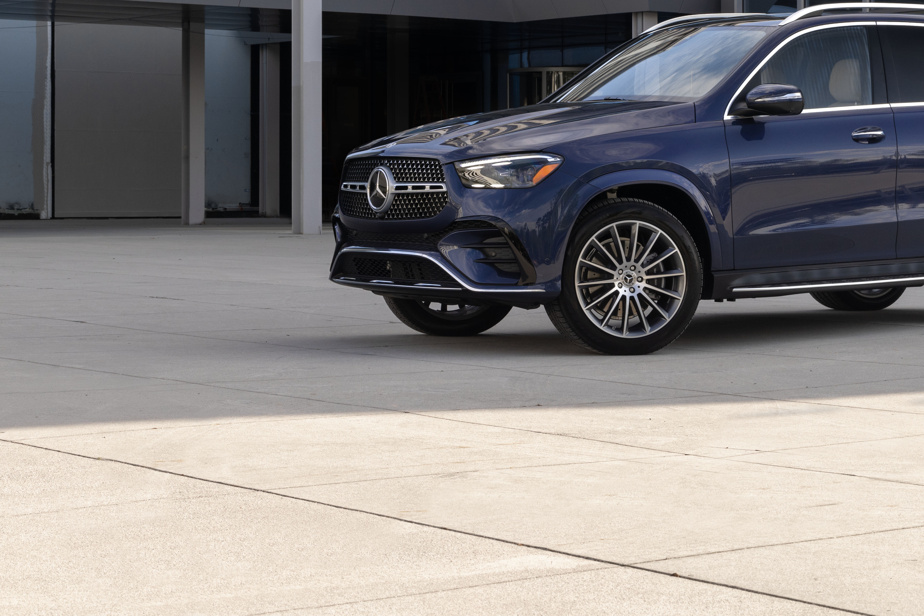Launched in 2018, the current GLE is the descendant of the instigator of the modern luxury SUV segment, the M-Class, born in 1997. Apart from the evolution driven by competition from the BMW X5, the canvas remains very similar. Slightly refreshed for 2024, its build remains defined by its curves, especially at the beltline and fenders. The huge 21-inch, 315-mm rims at the rear of the test vehicle add amplitude to the look. The headlights as well as the front shield have also been remodeled in the update, ultimately superficial changes. The generous glass surface is also inevitably reminiscent of the SUV trend of the early 2000s. The plug-in version is distinguished only by its name on the tailgate as well as by the presence of an additional hatch at the rear, for recharging.
This GLE belongs to what could be considered the old guard of the current Mercedes-Benz range. Its interior configuration therefore still uses several physical controls, a much more user-friendly approach than the most recent creations of the brand with the star which are used digitally. This dashboard also has the merit of bringing together elegant materials arranged as desired in a rectangular theme. The AMG Line group seats feature multiple adjustments and offer perfectly soft padding. The interior volume remains very satisfactory, no matter where you sit. However, things get complicated in terms of the practical aspect of the product: storage space is too rare and their capacity is insufficient for its purpose. The 892 L trunk is also significantly smaller than that of a Toyota RAV4.
The GLE 450e relies on an ingenious, but complex, hybrid powertrain. A 134-hp electric motor is housed in its nine-speed transmission to move the imposing 2.6-ton German cathedral. A 23.3 kWh battery provides an estimated range of 77 km, a realistic figure that can be increased in urban driving. Without being very lively, it quickly releases its torque, making driving this GLE serene and pleasant in an urban context. However, energy consumption is too high on the motorway, around 35 kWh/100 km. A 2.0L turbocharged four-cylinder then takes over, providing a total output of 381 hp. When it intervenes, the temperament of the SUV obviously changes due to the extra power, but its low noise level allows it to remain discreet. Its thirst – 10 L/100 km on average – is nevertheless quite high in hybrid operating mode given the displacement.
It appears quite clearly that this SUV has no real sporting pretensions, a frankness that we appreciate in a segment where superlatives are collected. The experience is therefore guided by a desire to isolate the driver from external irritants by soundproofing the roof barely disturbed by the winter crampons worn by the test model. The ride seems confident in its handling of movements, but the absence of optional air springs or any adaptive damping results in a slight dryness when negotiating imperfections. The rear axle also tends to translate its softness into a subtle lateral movement. Never mind, this GLE impresses with its impression of infrangibility coupled with a highly assisted steering wheel and progressive pedals which support the smoothness and homogeneity of the engine. It’s velvet.
Despite the support of some tactile keys, everything is not perfect in this department, far from it. This GLE has three touchpads, including two on the steering wheel, in addition to a few haptic keys. Navigation in the digital instrumentation and multimedia system is greatly complicated at times due to a lack of cohesion between the gesture made by the driver and the processing of the command by the system. It’s very time-consuming, especially when driving. However, the definition of the screens and the interface are excellent and support the obvious luxury of the SUV. The elegant Burmester audio system produces rich sound enhanced by the positioning of front foot-mounted bass drivers for a more sensory appearance. However, its power is a bit tight.
In no way can we characterize this GLE 450e as a highly efficient vehicle, especially when contrasted with purely electric options. This is the obvious consequence of its format, but also of the compromises induced by its design based on a thermal platform. This livery is nevertheless the most interesting of this model due to its ability to offer tens of kilometers of peace and quiet without burning a single drop of gasoline, a marked advantage. Despite these attributes embellished by its manufacturing quality, it is one of these transitional vehicles. Its technical complexity and the risk of more or less rapid technical obsolescence make its rental almost unavoidable, without disqualifying it.
